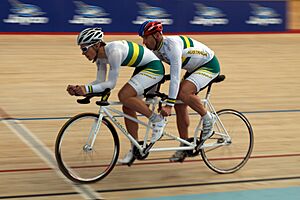Cycling at the Summer Paralympics facts for kids
Cycling is one of the most exciting sports at the Summer Paralympic Games. Athletes have been competing in cycling events at the Paralympics since the 1984 Games in New York.
What started with just seven road races has grown into a huge event. Now, athletes compete in both road and track events. Cycling is usually the third-largest sport at the Paralympics, right after athletics and swimming. There are about 50 different cycling events where athletes can win medals.
Contents
History of Cycling at the Paralympics
Cycling was not part of the first six Paralympic Games. It was added for the seventh Games in 1984 and has been included ever since. The table below shows the year each Games was held and which country won the most cycling medals.
| Games | Year | Events | Best Nation | |
|---|---|---|---|---|
| 1 | Not held | |||
| 2 | Not held | |||
| 3 | Not held | |||
| 4 | Not held | |||
| 5 | Not held | |||
| 6 | Not held | |||
| 7 | 1984 | 7 | ||
| 8 | 1988 | 7 | ||
| 9 | 1992 | 9 | ||
| 10 | 1996 | 23 | ||
| 11 | 2000 | 27 | ||
| 12 | 2004 | 31 | ||
| 13 | 2008 | 44 | ||
| 14 | 2012 | 50 | ||
| 15 | 2016 | 50 | ||
| 16 | 2020 | 51 | ||
| 17 | 2024 | 51 | ||
How Athletes are Grouped for Fairness

In Paralympic sports, it's important to make sure the competition is fair. Athletes are grouped, or classified, based on how their disability affects their ability to ride a bike. This system lets cyclists compete against others with a similar level of physical function.
Since the 2012 Summer Paralympics, a simple system has been used to group athletes:
- B: For cyclists with a visual impairment. They ride on a tandem bicycle (a bike for two people) with a sighted guide called a "pilot."
- T 1–2: For cyclists who have conditions like cerebral palsy that affect their balance. They use a tricycle for stability.
- C 1–5: For cyclists with disabilities like amputations or muscle weakness. They use a standard bicycle, which may be adapted for them. The lower the number (C1), the more significant the disability.
- H 1–4: For cyclists who use a handcycle, which is powered by their arms instead of their legs.
Generally, tricycle and handcycle races are held on the road, not on the track. Tandem bikes and standard bikes can be used on both the road and the track.
What is Factoring?
Sometimes, athletes from different classes compete in the same race. To keep it fair, a system called factoring is used. Factoring is like a handicap in golf. It adjusts the finish times of athletes in classes with more significant impairments.
This is done by using a percentage to lower their official time. The goal is to make sure the winner is the best athlete, not just the one with the least severe disability. For example, in a factored race, a C1 cyclist's final time might be reduced to balance out the physical advantages of a C3 cyclist. However, their actual race time is still recorded for world records in their own class.
Types of Paralympic Cycling
There are two main types of cycling at the Paralympics: road cycling and track cycling.
Road Cycling
Road cycling events take place on open roads. The main events are:
- Road Race: A long-distance race where all cyclists start at the same time. The first one to cross the finish line wins.
- Time Trial: A race against the clock. Each cyclist starts separately and tries to complete the course in the fastest time possible.
Track Cycling
Track cycling happens in a special arena with a banked, oval track called a velodrome. These races are often very fast and strategic. The main events are:
- Time Trial: Similar to the road time trial, but much shorter (500 or 1000 meters). It's an all-out sprint against the clock.
- Individual Pursuit: Two cyclists start on opposite sides of the track. They "pursue" each other for 3000 or 4000 meters. The winner is the one who either catches the other rider or finishes with a faster time.
- Team Sprint: A team event where riders work together to set the fastest time over a short distance.
Overall Medal Table
This table shows the total number of medals won by each country in Paralympic cycling up to the 2024 Games. Countries in italics no longer compete under that name.
| Rank | Nation | Gold | Silver | Bronze | Total |
|---|---|---|---|---|---|
| 1 | 59 | 38 | 21 | 118 | |
| 2 | 45 | 39 | 37 | 121 | |
| 3 | 30 | 40 | 35 | 105 | |
| 4 | 29 | 19 | 19 | 67 | |
| 5 | 28 | 23 | 28 | 79 | |
| 6 | 24 | 29 | 26 | 79 | |
| 7 | 18 | 19 | 18 | 55 | |
| 8 | 17 | 17 | 24 | 58 | |
| 9 | 15 | 18 | 24 | 57 | |
| 10 | 9 | 13 | 17 | 39 | |
| 11 | 8 | 14 | 9 | 31 | |
| 12 | 8 | 7 | 10 | 25 | |
| 13 | 7 | 6 | 4 | 17 | |
| 14 | 7 | 5 | 4 | 16 | |
| 15 | 6 | 7 | 6 | 19 | |
| 16 | 5 | 9 | 9 | 23 | |
| 17 | 5 | 7 | 4 | 16 | |
| 18 | 5 | 3 | 2 | 10 | |
| 19 | 4 | 9 | 10 | 23 | |
| 20 | 4 | 1 | 0 | 5 | |
| 21 | 3 | 6 | 5 | 14 | |
| 22 | 3 | 2 | 5 | 10 | |
| 23 | 3 | 2 | 3 | 8 | |
| 24 | 3 | 0 | 0 | 3 | |
| 25 | 2 | 4 | 8 | 14 | |
| 26 | 2 | 0 | 1 | 3 | |
| 27 | 1 | 3 | 0 | 4 | |
| 28 | 0 | 2 | 3 | 5 | |
| 29 | 0 | 2 | 0 | 2 | |
| 0 | 2 | 0 | 2 | ||
| 31 | 0 | 1 | 2 | 3 | |
| 0 | 1 | 2 | 3 | ||
| 33 | 0 | 1 | 1 | 2 | |
| 34 | 0 | 1 | 0 | 1 | |
| 35 | 0 | 0 | 7 | 7 | |
| 36 | 0 | 0 | 2 | 2 | |
| 0 | 0 | 2 | 2 | ||
| 38 | 0 | 0 | 1 | 1 | |
| Totals (38 entries) | 350 | 350 | 349 | 1,049 | |
See also
 In Spanish: Ciclismo en los Juegos Paralímpicos para niños
In Spanish: Ciclismo en los Juegos Paralímpicos para niños
- Cycling at the Summer Olympics
- Cycle sport
- Para-cycling
- Para-cycling classification
- UCI Para-cycling Road World Championships
- UCI Para-cycling Track World Championships


